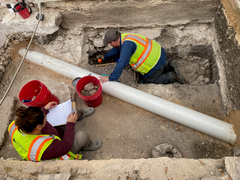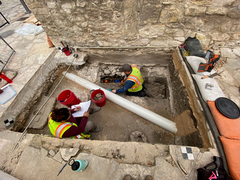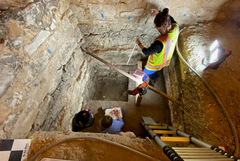During the week of March 9, 2020, archaeological investigations associated with the preservation work and the installation of the bollards was slowed by the rain. In addition, work was nearing an end in both projects. The archaeologists from the University of Texas at San Antonio’s Center of Archaeological Research (UTSA-CAR) conducted unit excavations along the north side of the Long Barrack. Initial shovel testing had encountered an area of potential limestone features.
Archaeology Update — Archaeological Investigations Nearing End
Three units were excavated to explore their potential features. The additional investigations found that the area was greatly disturbed, and they encountered limestone rubble rather than a foundation. Artifacts encountered revealed the amount of disturbance, with charcoal, asphalt, glass, metal, and plastic mixed with limestone cobbles. It is likely that this deposit is a result of previous construction activity in the area. During the following week, the archaeologists should return to complete investigations that will allow for the bollards to be installed.
Archaeological excavations associated with the preservation project completed excavations by the end of the week. A small section in Excavation Unit 9b, located on the south side of the Long Barrack, was completed by Friday afternoon. Archaeologists from Raba Kistner revealed the base of the Long Barrack foundation at approximately 3.2 feet below datum. The foundation is sitting on top of a naturally occurring geological formation. Archaeologists spent the latter part of the week clearing off the base of the unit as well as exposing the stones of the foundation. Documentation will continue into the following week, but no more excavations are planned in this unit.


On the south side of the Church, Excavation Unit 3 reached the base of the foundation at approximately 74.8 inches below datum. This appears to be the deepest excavations conducted during the project.
Similar to the other units, the naturally occurring geological formation provides a stable base for building the foundation. The archaeologists were able to document that the base of the foundation is sitting atop this formation. The last few levels of excavations did not produce artifacts, encountering mostly snail shells as the only inclusion to the soils.

Archaeologists will spend time during the next week to complete documentation of the units and allow the Preservation Team to conduct their investigations by placing the moisture sensors below ground. After that has occurred, the soils will be replaced in the same levels as they were removed and reverted back to the same compaction and moisture content that was recorded during the excavations. This will allow for a shortened calibration period for the sensors to begin collecting accurate data.

